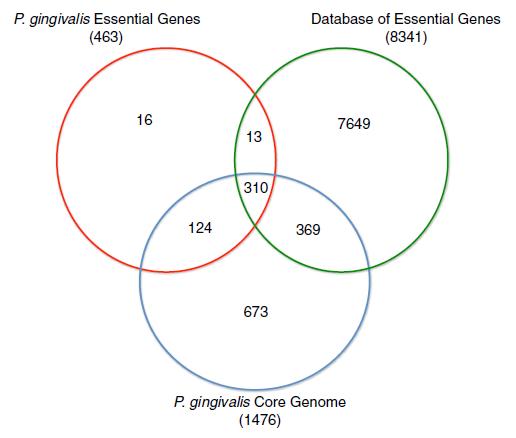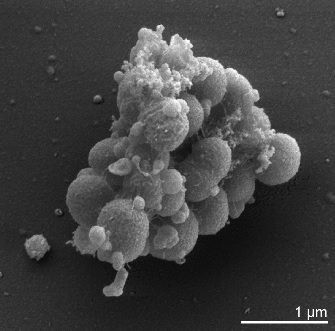Porphyromonas gingivalis
Ron Ramsay, Bench C, September 23, 2016 [3]
Classification
Higher order taxa
(domain) Bacteria — (phylum) Bacteroidetes — (class) Bacteroidia — (order) Bacteroidales — (family) Porphyromonadaceae — (genus) Porphyromonas [4][5]
Species
Porphyromonas gingivalis
Type strain: 2561 = ATCC 33277 = BCRC 14417 = CCRC 14417 = CCUG 25893 = CCUG 25928 = CIP 103683 = Coykendall 2561 = DSM 20709 = JCM 12257 = KCTC 5121 = NCTC 11834 = Slots 2561 [5][6]
Description and significance
Give a general description of the species (e.g. where/when was it first discovered, where is it commonly found, has it been cultured, functional role, type of bacterium [Gram+/-], morphology, etc.) and explain why it is important to study this microorganism. Examples of citations [1], [2]
Etymology: N.L. fem. dim. n. Veillonella, named after Adrien Veillon, the French microbiologist who isolated the type species.
Genome structure

Select a strain for which genome information (e.g. size, plasmids, distinct genes, etc.) is available.
Cell structure and metabolism
Cell wall, biofilm formation, motility, metabolic functions.
Ecology
Aerobe/anaerobe, habitat (location in the oral cavity, potential other environments) and microbe/host interactions.
Pathology
Do these microorganisms cause disease in the oral cavity or elsewhere?
Application to biotechnology
Bioengineering, biotechnologically relevant enzyme/compound production, drug targets,…
Current research
Summarise some of the most recent discoveries regarding this species.
References
- ↑ Nakayama, K. (2015). Porphyromonas Gingivalis and Related Bacteria: From Colonial Pigmentation to the Type Ix Secretion System and Gliding Motility. J Periodontal Res 50:1-8. doi:10.1111/jre.12255.
- ↑ 2.0 2.1 Shah, H. N. and M. D. Collins. (1988). Proposal for Reclassification of Bacteroides Asaccharolyticus, Bacteroides Gingivalis, and Bacteroides Endodontalis in a New Genus, Porphyromonas. Int J Syst Evol Microbiol 38:128-31. doi:10.1099/00207713-38-1-128.
- ↑ MICR3004: Microbial Genomics. University of Queensland. MICR3004 course information
- ↑ NCBI Taxonomy Browser
- ↑ 5.0 5.1 StrainInfo.net. Porphyromonas gingivalis
- ↑ LPSN: List of prokaryotic names with standing in nomenclature. Porphyromonas
- ↑ Cite error: Invalid
<ref>tag; no text was provided for refs namedNobody - ↑ Mysak, J., S. Podzimek, P. Sommerova, Y. Lyuya-Mi, J. Bartova, T. Janatova, J. Prochazkova, and J. Duskova. (2014). Porphyromonas Gingivalis: Major Periodontopathic Pathogen Overview. J Immunol Res 2014:8. http://dx.doi.org/10.1155/2014/476068.
- ↑ Tan, K. H., C. A. Seers, S. G. Dashper, H. L. Mitchell, J. S. Pyke, V. Meuric, N. Slakeski, S. M. Cleal, J. L. Chambers, M. J. McConville, and E. C. Reynolds. (2014). Porphyromonas Gingivalis and Treponema Denticola Exhibit Metabolic Symbioses. Plos Pathogens 10:e1003955. doi:10.1371/journal.ppat.1003955.
- ↑ Cite error: Invalid
<ref>tag; no text was provided for refs namedKlein - ↑ Genbank nucleotide sequence database. accession: AP009380.1: "Porphyromonas gingivalis ATCC 33277 DNA, complete genome"
This page is written by Ron Ramsay for the MICR3004 course, Semester 2, 2016

